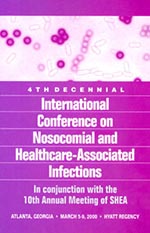Volume 7, Number 2—April 2001
THEME ISSUE
4th Decennial International Conference on Nosocomial and Healthcare-Associated Infections
Introduction
About the Fourth Decennial International Conference on Nosocomial and Healthcare-Associated Infections
On March 5-9, 2000, 2,500 infection control professionals, epidemiologists, microbiologists, physicians, nurses, laboratory scientists, and other medical professionals from 55 countries convened in Atlanta for the Fourth Decennial International Conference on Nosocomial and Healthcare-Associated Infections (Figure). The goals of this conference, like those of its predecessors in 1970, 1980, and 1990, were to provide the latest scientific information in the field and help shape the agenda for research and prevention activities in the coming decade.
The theme of the conference was "Prevention is Primary." More than 800 scientific papers, abstracts, and lectures were presented in 50 plenary sessions, symposia, panels, slide presentations, and poster sessions during the 5 days of the conference. The epidemiology, microbiology, and prevention of antimicrobial-drug resistant infections were recurring topics, as were new knowledge and current research on bloodstream infections, surgical site infections, and pneumonia associated with health care. Areas of particular emphasis included infection prevention in special populations, including pediatric, geriatric, and immunocompromised patients; infection control in nonhospital settings, including long-term care, home health care, and ambulatory care; preventing infections in health-care personnel; and new technologic developments in microbiology, the design and use of medical devices, facilities engineering, and information systems.
Each of the four decennial conferences has documented remarkable scientific advances and achievements in preventing and controlling infections associated with health care. Each conference has also presented the emerging challenges brought by each decade's changes in the epidemiology and microbiology of pathogens, the growing numbers of patients with increased susceptibility to infection, the rapidly increasing complexity of medical care itself, and the dramatic developments in the organization, structure, and financing of health care. Many speakers addressed topics that have evolved over three decades but continue to be vital areas of research and investigation, such as antimicrobial-drug resistance, device-associated infections, and surveillance. Also featured were presentations on subjects that have grown in prominence only in recent years: information technology, patient safety, health-care economics, outcomes research, and managed care.
In publishing the conference presentations in this journal, the organizers hope to capture the extraordinary breadth of the science in this area; maintain the ongoing record of advances in infection prevention and control during these past 30 years; and help promote research, demonstration, and evaluation efforts to improve health-care quality and to protect patients and health-care personnel from this continuing threat to their safety.
The conference was organized and sponsored by the Centers for Disease Control and Prevention, the Association for Professionals in Infection Control, the Society for Healthcare Epidemiology of America, and the National Foundation for Infectious Diseases.
Acknowledgment
The organizers of the conference thank the following persons on the Fourth Decennial Conference Publications Committee for their work in assembling this proceedings: Steven L. Solomon, Chair, Elaine Larson, Loreen Herwaldt, J. Michael Miller, William J. Martone; as well as CDC staff Machel Forney, J Shaw, and Denise Cardo.
Figure
Cite This ArticleTable of Contents – Volume 7, Number 2—April 2001
| EID Search Options |
|---|
|
|
|
|
|
|
